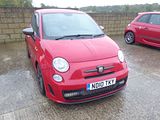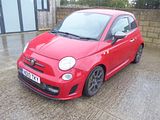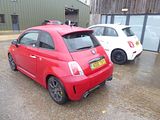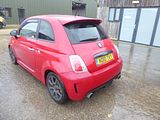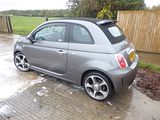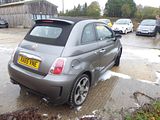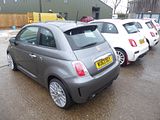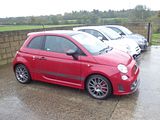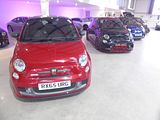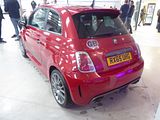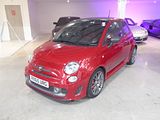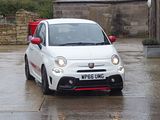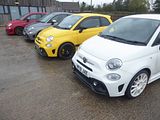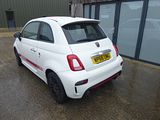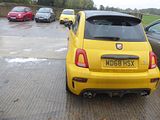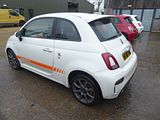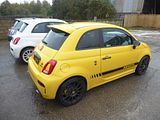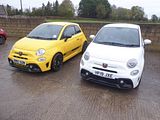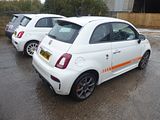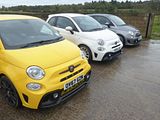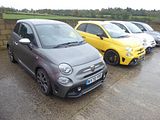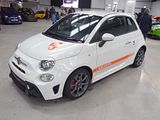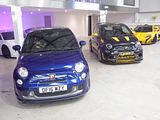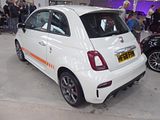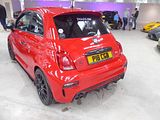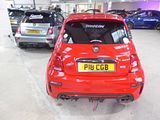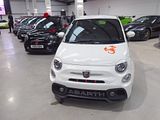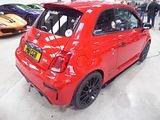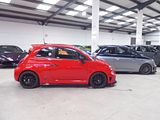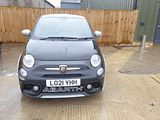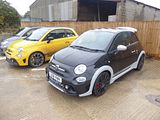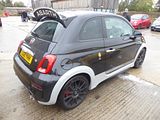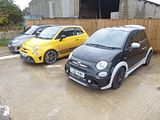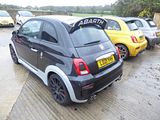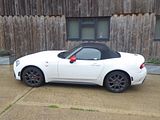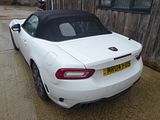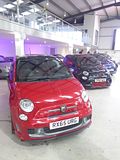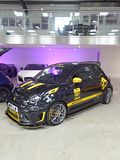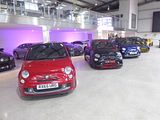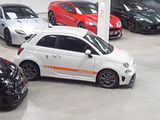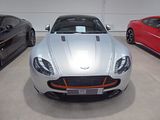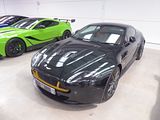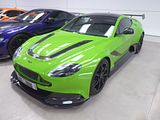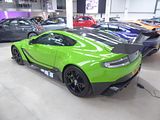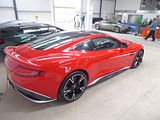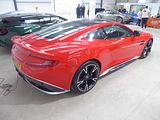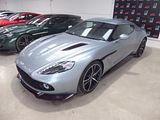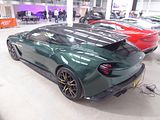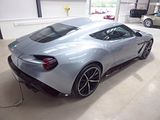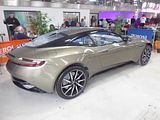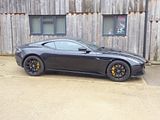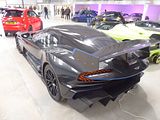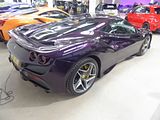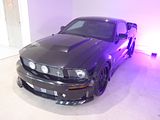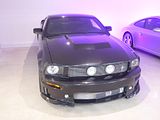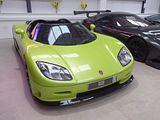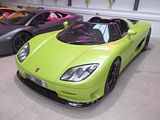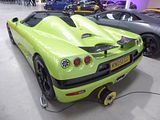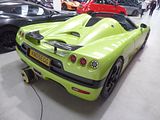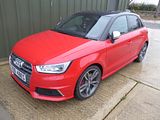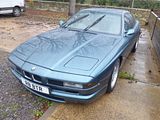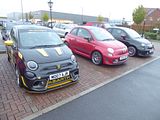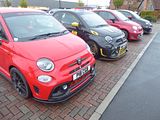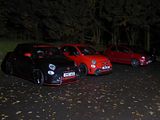Destination for the latest meeting for the recently formed Abarth Wiltshire & Avon Group was one I’d not heard of: Five Zeros Supercars, which is to be found on the outskirts of Bradford on Avon. It’s the sort of place that you could easily drive past without realising what is there, and that is probably no accident, as given the value of what is on site, the drawing extra attention to it all is probably not a terribly good idea. That said, as the venue is open to the public, word will get out pretty quickly. Genesis of the idea came from an entrepreneur called David Bushe who owns a number of supercars and who needed somewhere to store them. And as is often the case, he knew a few other people who also needed a storage facility of the right calibre for their equally valuable cars, so he set about converting one of the barns at his farm premises to house both his cars and those belonging to a few friends. It was not long before he figured that he as well as making money from the storage fees, he could make more money by opening up to the public and allowing them to come and see the cars and get coffee and a limited range of food items. And so his expansion plans began. What I saw on this visit was just the beginning of what is to come: there are 3 barns and he hopes to use them all, with one becoming the UK centre for Keonigsegg, one being very private and one being open to the public. A larger kitchen area is desperately needed now, as the very limited space here struggled to cope with the volume of requests and I ended up waiting over an hour for a simple burger, and this was after someone had had to go out to buy more milk and bacon. That will come, as among other ideas, is one to do private openings with on site catering and taking advantage of a huge tv screen for watching things like Formula 1 live. Even without advertising any of this, people have started to come and visit and on the day we went, which was a particularly wet and grimy day, there were vast numbers of people that were nothing to do with Abarth or the supercars who dropped by to have a look. Apparently numbers do vary massively as the previous weekend had seen precisely two visitors all day, so it is hard to predict what any one day will be like. Here is what I saw during my visit:
THE ABARTHS
When I arrived, there were already a number of Abarths parked up outside, but arrangements had been made for as many of the cars as possible to be brought inside and so gradually owners moved their cars indoors, where an army of enthusiastic members set about cleaning them. I felt almost guilty letting others make my car presentable, but they certainly did a good job.
The vast majority of Abarth cars here were the 500-based models which have been on sale now since the end of 2008, following a launch at the Paris Show that year. Since that time there have been a number of detailed changes to the standard cars and a lot of limited editions. Those who really know the marque can spot most of them, but some are so subtle that unless there is a badge you can see, you will not be quite sure which version you are looking at. It used to be relatively easy, when the model was first launched, as there was only one version as shipped ex works called the 500. It had a 135 bhp 1.4 litre turbo-charged engine coupled to a five speed manual gearbox, with 16″ alloys as standard, and the option of 17″ wheels, and a colour palette comprising of two whites (BossaNova White, the standard colour, or the pearlescent Funk White), Red (Pasadoble), Pale Grey (Campovolo) or Black. If you wanted more power – 160 bhp – then you could order an Esseesse kit, which came in a large wooden crate, containing new wheels, springs, an ECU upgrade, the Monza exhaust system and badging. It was dealer fitted and could be applied at any time within the first 12 months or 10,000 miles from registration. Needless to say, it proved popular. As were many of the optional extras, with stickers for the sides, a large scorpion for the bonnet and even a chequered pattern for the roof among the personalisation options offered.
Whilst a sliding glass sunroof (Skydome in Fiat/Abarth parlance) was an option from inception, fans of open air motoring had to wait until Geneva 2010 for the launch of the 500C models. For the first few months these cars only came with the robotised manual gearbox, which limited the appeal in the eyes of some, but they also introduced us to the “bi-colore”, a series of two tone cars, with upper and lower halves of the body painted in different colours. It took us a while to get used to this, as no other production road cars had been painted like this for some time, but now this is seen as yet another of those marque defining attributes, and (perhaps with the exception of the rarely seen Rally Beige and Officina Red combination that would come for 2014) in the eyes of many this distinctive look enhances the appeal of the cars still further.
Having used the legendary 695 badging from the 1960s on the Tributo cars, at the 2012 Geneva Show, Abarth dusted off the 595 name that had been used on the less powerful of the Nuova 500 based cars of the same generation, and created two new versions which we should think of as Series 2 cars, the 595 Turismo and Competizione, both of which could be bought in either closed or open top C guise, with either the 5 speed manual or robotised automated gearshifts. Both models had the 160 bhp engine as standard. Effectively they were a replacement for the Esseesse kit, and it meant that the cars were produced complete at the factory, rather than needing the dealer to undertake the upgrade (and the associated paperwork), though Abarth did not withdraw the Esseesse kits from the market for some while. Turismo, as the name suggests was aimed slightly less extreme in intent, featuring standard leather upholstery, upgraded dampers and climate control, Xenon headlights and Alutex interior details. The sportier Abarth 595 Competizione replaced the leather seats with Sabelt cloth sport seats and Alutex with aluminium, while adding p-cross-drilled brakes and the Record Monza dual-mode exhaust.
Rumours started to circulate towards the end of 2014 that Abarth were going to upgrade the Competizione model, so as better to bridge the gap between the Turismo and the 190 bhp 695 Biposto that had been added to the range earlier in the year. It was Geneva 2015 when the result was finally shown to an expectant fan base. Most exciting news was that thanks to a bigger Garrett Turbo, the engine had been tweaked to 180 bhp, and with reduced CO2 emissions. A standard spec that included Koni Dampers, Brembo brakes, Xenon lights, Sabelt seats, Climate Control, parking sensors as well as other refinements that had been added like the TFT instrument display all proved very compelling, so not long after the first cars reached the UK in June of 2015, I found temptation too hard to resist, and as is well documented here, swapped my 2010 car for one of these. At the time I ordered it, Cordolo Red, a tri-coat pearlescent paint which shimmers in bright sunlight looked set to become one of the most popular colours of the lot, even though it is a cost option. Indeed, the Launch Edition models were all offered either in this colour or Scorpion Black, with black wheels. Surprisingly, the colour was not carried over to the Series 4 cars.
What is known as the Series 4 version of the familiar 595 reached the markets in the middle of 2016. After rumours had circulated all winter following the launch of the facelifted Fiat 500 last year, Abarth finally unveiled the Series 4 at the end of May 2016. Initially, we were told that the cars would not be available in the UK until September, but that came forward somewhat, with dealers all receiving demo cars in June, and the first customers taking delivery in July. Three regular production versions of both the closed car and the open-topped C were initially available, all badged 595, and called Custom, Turismo and Competizione, as before, though numerous limited edition models have since appeared and in most case disappeared. The most significant changes with the Series 4 are visual, with a couple of new colours, including the much asked for Modena Yellow and a different red, called Abarth Red, which replaces both the non-metallic Officina and – slightly surprisingly – the tri-coat pearlescent Cordolo Red. as well as styling changes front and rear. The jury is still out on these, with many, me included, remaining to be convinced. At the front, the new air intake does apparently allow around 15 – 20 % more air in and out, which will be welcome, as these cars do generate quite a lot of heat under the bonnet. Competizione models for the UK retain the old style headlights, as they have Xenon lights as standard, whereas the Custom and Turismo cars have reshaped units. At the back, there are new light clusters and a new rear bumper and diffuser. Inside, the most notable change is the replacement of the Blue & Me system with a more modern uConnect Audio set up, which brings a new colour screen to the dash. Mechanically, there is an additional 5 bhp on the Custom (now 145) and Turismo (now 165 bhp) and the option of a Limited Slip Diff for the Competizione, which is likely to prove a popular option. Details of the interior trim have changed, with a filled-in glovebox like the US market cars have always had, and electric windows switches that are like the US ones, as well as a part Alcantara trim to the steering wheel in Competizione cars. These cars have now been on offer for six years and with Abarth sales on the rise, it was no surprise that they were particularly well represented here.
The 695 Anniversario was launched at the brand’s 70th anniversary celebrations in Milan in October 2019, and deliveries of which started around the turn of the year. The Anniversario is in a choice of 5 colours: White, Black, Podium Blue, Grey and 1958 Green, and there were examples of some but not all of these here, including a couple of cars in the 1958 Green which was selected to evoke memories of the 1958 record-breaking 500, though I can advise that the two shades of green are quite different, the older car being much lighter. Online verdicts of the new car at launch were not entirely positive, with many challenging the appearance, others the spec and yet more the price (£29,995 in the UK), but in the metal, it looks far better than those first web pictures portrayed, and there is no doubt that the 1949 buyers of the car are getting something quite distinctive, with the Campovolo Grey accents around the wheelarches and lower body skirts. What they aren’t getting is more than 180 bhp, as it would seem that to get Euro 6d compliance from the T-Jet engine, 180 bhp is the limit. But the Abarth 695 70° Anniversario does have an ace up its sleeve. Look at the back and you’ll notice a rather large roof-mounted spoiler serving as the special edition’s party piece. Manually adjustable in literally a dozen of positions, the spoiler was developed in the wind tunnel to achieve maximum aero efficiency regardless of speed. Its inclination varies from 0 to 60 degrees and helps increase aerodynamic load by 42 kilograms when the car is travelling at speeds of 124 mph (200 km/h) provided the spoiler is at its maximum inclination. Abarth has done the maths and it claims the new aero component will reduce steering corrections by as much as 40% based on the testing they’ve done at FCA’s wind tunnel in the Orbassano municipality located southwest of Turin. Power is provided by the familiar 1.4-litre turbocharged engine with 180 hp and 250 Nm (184 lb-ft) of torque, good enough for a sprint from 0 to 62 mph (100 km/h) in 6.7 seconds before topping out at 140 mph (225 km/h) if the spoiler is in the 0° position. Those 17-inch SuperSport wheels are paired to a Brembo braking system with four-piston aluminium calipers finished in red, hugging the 305-mm front and 240-mm rear self-ventilated discs. Rounding off the changes on the outside is the newly developed Record Monza exhaust with active valve for a better soundtrack. Abarth also spruced up the cabin a bit where the body-hugging seats are exclusive to this special edition, just like the individually numbered plaque reminding you this isn’t an ordinary 695. Onboard tech includes support for both Apple CarPlay and Android Auto, DAB digital radio and a navigation system for that seven-inch touchscreen display. Additional standard equipment includes automatic climate control, daytime running lights, LED fog lights, unique mats, and the Abarth telemetry system if you plan on taking the hot hatch to the track.
The Abarth 124 Spider was developed in parallel with the Fiat model. It does cost a lot more, and there are those who think you don’t get enough extra for your money, but those who have driven it will tell you otherwise. You certainly get more power. The 1.4 MultiAir turbo unit jumps up from 138bhp to 168bhp, while torque also increases by a modest 10Nm to 250Nm, which gives it a 0-62mph time of 6.8 seconds, which is half a second quicker than the 2.0-litre Mazda MX-5. The top speed is 143mph. It weighs just 1060kg meaning a power-to-weight ratio of 158bhp-per-tonne, and with the new Record Monza exhaust system it sounds great even at idle. The Abarth version gets a stiffer suspension setup than the regular Fiat 124 Spider, with Bilstein dampers and beefed-up anti-roll bars. Bigger Brembo brakes also feature, with aluminium calipers. It can be had with a six-speed manual or six-speed automatic transmission with paddles, and the latter gets a Sport mode for quicker shifts. Many of the UK cars sport the ‘Heritage Look’ pack, which is a no-cost option. It brings a matt black bonnet and bootlid, plus red exterior trim detailing and has proved popular. The £29,565 starting price gets you standard equipment such as cruise control, climate control, Bluetooth, a DAB radio and satnav, plus Alcantara black and red (or pure black) seat trim. The automatic gearbox is a £2,035 extra, while an optional visibility pack brings LED DRLs, auto lights and wipers and rear parking sensors. Sales ceased during 2019, with around 1800 cars having been brought into the UK, so this is always going to be a rare car, and values are already increasing at a rate reflecting its desirability and the difficulty in finding one.
We ended up with quite an array of newly cleaned Abarths parked in the central area of the unit, and am impressive display they did indeed make.
SUPERCARS
Inside the main building are an array of supercars and hypercars. Some belong to David Bushe himself, some to friends and some to a high end dealer. They make for an impressive sight!
ALFA ROMEO
This is one of David’s cars and the only one, he told me, that his wife is happy to travel in. It may look more or less like an ordinary Stelvio but needless to say, it has been upgraded somewhat beyond even the bonkers Quadrifolgio spec and power output.
ASTON MARTIN
Following the unveiling of the AMV8 Vantage concept car in 2003 at the North American International Auto Show designed by Henrik Fisker, the production version, known as the V8 Vantage was introduced at the Geneva Motor Show in 2005. The two seat, two-door coupé had a bonded aluminium structure for strength and lightness. The 172.5 inch (4.38 m) long car featured a hatchback-style tailgate for practicality, with a large luggage shelf behind the seats. In addition to the coupé, a convertible, known as the V8 Vantage Roadster, was introduced later in that year. The V8 Vantage was initially powered by a 4.3 litre quad-cam 32-valve V8 which produced 380 bhp at 7,300 rpm and 409 Nm (302 lb/ft) at 5,000 rpm. However, models produced after 2008 had a 4.7-litre V8 with 420 bhp and 470 Nm (347 lbft) of torque. Though based loosely on Jaguar’s AJ-V8 engine architecture, this engine was unique to Aston Martin and featured race-style dry-sump lubrication, which enabled it to be mounted low in the chassis for an improved centre of gravity. The cylinder block and heads, crankshaft, connecting rods, pistons, camshafts, inlet and exhaust manifolds, lubrication system and engine management were all designed in house by Aston Martin and the engine was assembled by hand at the AM facility in Cologne, Germany, which also built the V12 engine for the DB9 and Vanquish. The engine was front mid-mounted with a rear-mounted transaxle, giving a 49/51 front/rear weight distribution. Slotted Brembo brakes were also standard. The original V8 Vantage could accelerate from 0 to 60 mph in 4.8 seconds before topping out at 175 mph. In 2008, Aston Martin introduced an aftermarket dealer approved upgrade package for power and handling of the 4.3-litre variants that maintained the warranty with the company. The power upgrade was called the V8 Vantage Power Upgrade, creating a more potent version of the Aston Martin 4.3-litre V8 engine with an increase in peak power of 20 bhp to 400 bhp while peak torque increased by 10 Nm to 420 Nm (310 lb/ft). This consists of the fitting of the following revised components; manifold assembly (painted Crackle Black), valved air box, right and left hand side vacuum hose assemblies, engine bay fuse box link lead (ECU to fuse box), throttle body to manifold gasket, intake manifold gasket, fuel injector to manifold seal and a manifold badge. The V8 Vantage had a retail price of GB£79,000, US$110,000, or €104,000 in 2006, Aston Martin planned to build up to 3,000 per year. Included was a 6-speed manual transmission and leather-upholstery for the seats, dash board, steering-wheel, and shift-knob. A new 6-speed sequential manual transmission, similar to those produced by Ferrari and Lamborghini, called Sportshift was introduced later as an option. An open-topped model was added to the range in 2006 and then in the quest for more power a V12 Vantage joined the range not long after. There were no fewer than 18 different versions of the Vantage produced during its production run. Among the most distinctive are the N420 cars with special two-colour paintwork, like this one. The N420 became the successor to the special edition N400 of 2007, based upon the standard 4.7-litre V8 Vantage and available either a coupé or roadster and with either the 6-speed manual or optional 6-speed Sportshift transmission. The motorsport-inspired V8 Vantage N420 came with the Sports Pack suspension as standard, a new sports exhaust system, and many carbon-fibre components which resulted in a 27 kg (60 lb) weight saving over the standard car. In addition, the N420 has distinctive Aston Martin ‘Race Collection’ paint schemes available as an option although any other colour could be specified. Along with that, the N420 has the extended N400 sills, a carbon-fibre front splitter, side strakes, and diffuser along with 10-spoke diamond turned alloy wheels with gloss black finish, black mesh vents, and ‘Graphitic’ tailpipe finishers. The N420 was available as either a coupé or Roadster.
During 2016, a handful of lucky customers were able to take delivery of one (or both) of a couple of very special versions of the Vantage offered, the GT8 and GT12, and an example of the latter was here. First of them was the Vantage GT12. This started out as the Aston Martin Vantage GT3 special edition when it was unveiled at the Geneva Motor Show 2015. The company said that they would only manufacture 100 cars. After a complaint from Porsche over the use of the “GT3” moniker, the car was renamed the Vantage GT12. It features a new iteration of the 6.0-litre V12 that produces 592 bhp and 461 lb/ft of torque. It has a kerb weight of 1,535 kg (3,384 lb), and can accelerate from 0 to 60 mph in 3.5 seconds. There were sufficient external alterations that you would know that you were looking at something very special. For the Vantage GT8, which was launched a year later, Aston decided to make more cars – 150 of them, which was 50 more than the GT12. The GT8 features the same 4.7-litre V8 as found in the base Vantage but with power now increased to 440 bhp, and has a top speed of 190 mph (310 km/h). The GT8 is available with either a 6-speed manual or a 7-speed Sportshift II automated manual transmission, and has a kerb weight of 1,510 kg (3,329 lb), a 100 kg (220 lb) reduction over the V8 Vantage S.
This version of the Vanquish started life as the Project AM310 Concept that was unveiled at the 2012 Concorso D’Eleganza at Villa D’Este on the shores of Lake Como, Italy. The concept car was based on the fourth generation VH platform. It included a tweaked version of Aston Martin’s familiar grille and headlight design and a more pronounced bulge in the bonnet – with the real One-77-inspired flourishes saved for the sides and the rear, the side vents run almost to the door handles (from One-77), new rear light design from One-77, and a 5.9-litre V12 engine that produced 550 PS. Aston Martin later announced that the concept would be put into production as the all new Aston Martin Vanquish. The exterior styling of the Vanquish is an evolution of the DBS with many styling cues such as the elongated side strakes being inspired by the Aston Martin One-77. The boot lid included an integrated rear spoiler designed to look as if it is impossible to make; this was done on the orders of Aston Martin Chief Executive, Dr. Ulrich Bez. The car has an exposed carbon fibre side skirt showing its all carbon fibre body. The Vanquish uses the new VH Generation IV platform which is lighter and uses more carbon fibre components than the VH Generation II platform used in the DBS. The car featured an all new interior based on the one found in the exclusive One-77. The standard interior was trimmed in hand stitched leather and alcantara and was available in a range of colours. The centre console features a revised infotainment system over the one found in the DBS. The car was available as either a 2-seater or 2+2. The Vanquish used an upgraded version of Aston Martin’s flagship 5.9-litre AM11 V12 engine called the AM28 with a power output of 565 bhp at 6,750 rpm and torque of 457 lb/ft at 5,500 rpm. The Vanquish can accelerate from 0 to 100 km/h (62 mph) in 4.1 seconds, and has a top speed of 295 km/h (183 mph). Like most Aston Martins, the engine is front mid-mounted for better weight distribution, with the power going to the rear wheels. The Vanquish has 51/49 front/rear weight distribution, and a kerb weight of 1,739 kg (3,834 lb). It uses a fully catalysed stainless steel exhaust system with active bypass valves. The Vanquish uses an updated Touchtronic II six-speed automatic gearbox. It was the first Aston Martin model to be available with launch control. The combined space of cabin and a boot that, at 368 litres, is more than 60% larger than that of the DBS. The brakes are ventilated carbon ceramic discs, 398 mm (15.7 in) six-piston callipers in the front and 360 mm (14.2 in) four-piston callipers in the rear. The suspension is a lightweight aluminium front subframe with hollow castings with independent double wishbones incorporating anti-dive geometry, coil springs, anti-roll bar, and monotube adaptive dampers in the front and independent double wishbones with anti-squat and anti-lift geometry, coil springs, anti-roll bar, and monotube adaptive dampers in the rear. It has a three-stage adjustable adaptive damping system including normal, sport and track modes. The tyres are Pirelli P Zeros, 255/ZR20 in the front and 305/30 ZR20 in the rear. The vehicle was unveiled in the London Film Museum, Covent Garden, followed by 2012 Monterey Car Week. Deliveries to UK and Continental Europe began in late 2012. In August 2014, Aston Martin revealed technical modifications to the Vanquish. The changes include a new eight-speed Touchtronic III gearbox and upgraded AM29 V12 engine that produces 568 bhp and torque of 465 lb/ft. The changes greatly enhanced performance, with an acceleration of 0 to 100 km/h (62 mph) in 3.6 seconds, and a top speed of 324 km/h (201 mph). In 2013, Aston Martin unveiled a convertible version of the Vanquish, called Volante. The Volante includes a full carbon fibre body, triple-skin lightweight fabric roof, 50% larger boot than its predecessor and the third generation Brembo 398 mm × 36 mm front and 360 mm × 32 mm CCM rear Carbon Ceramic Matrix (CCM) brake discs with six-piston front and four-piston rear brake callipers (from the One-77). The Vanquish Volante is 13% torsionally stiffer than the outgoing DBS Volante. The carbon fibre-skin of the Vanquish Volante was created by the engineering team at Aston Martin. The vehicle was unveiled at the 2013 Pebble Beach Concours d’Elegance. Deliveries to Europe began in late 2013. On 16 November 2016, Aston Martin announced the new Vanquish S model. The Vanquish S features the same AM29 V12 engine, with power now increased to 595 bhp, and a new aerodynamic package. The Vanquish S can accelerate from 0 to 100 km/h (62 mph) in 3.5 seconds, and the top speed remains unchanged at 201 mph (324 km/h). The starting price at launch was £199,950 and deliveries started in December 2016. Aston Martin also unveiled a convertible version of the Vanquish S called the Vanquish S Volante in 2017.
In 2017 Aston Martin announced a limited series production of the Aston Martin Vanquish Zagato; the latest creation from its long-standing partnership with the prestigious Italian design-house Zagato. The Vanquish Zagato Concept was unveiled to great acclaim at the prestigious Concorso d’Eleganza Villa d’Este at Lake Como, Italy in May 2016. The Vanquish Zagato is available in 4 body styles – coupé, convertible, speedster, and shooting brake. 99 each were built of the coupé, convertible, and shooting brake, while a mere 28 speedsters were made, for a total of 325 cars. The Vanquish Zagato features the same AM29 V12 from the Vanquish S, which has a power output of 603 PS (595 bhp) and 630 Nm (465 lb/ft) of torque, allowing the Vanquish Zagato to accelerate from 0 to 100 km/h (62 mph) in 3.5 seconds before reaching a top speed of 324 km/h (201 mph).
Also here was an example of the DB11, still a current model.
The Aston Martin Vulcan is a two-door, two-seat, high-performance lightweight track-only car launched at the 2015 Geneva Motor Show. The Vulcan was designed by Aston Martin’s creative officer Marek Reichman, taking inspiration from then-current Aston Martin models such as the Vantage, the DB9 and the One-77. Production totalled 24 cars, with each priced at US$2.3 million. One was included with the penthouse of Aston Martin Residences tower in Miami. The engine, a 7.0-litre naturally-aspirated V12, mounted in an aluminium alloy chassis with a carbon fibre body, has a power output of 831 PS (820 bhp) at 7,750 rpm and 575 lb/ft (780 Nm) of torque at 6,500 rpm. The top speed (without the wing) is 208 mph (335 km/h) and 0-60 time is 2.9 seconds. The Vulcan is fitted with a magnesium torque tube which has a carbon fibre propeller shaft, a limited-slip differential and an Xtrac 6-speed sequential transmission. The car has a dry kerb weight of 1,350 kg (2,976 lb). It uses Michelin Pilot Sport Cup 2 tires, which are fitted on 19 inch APP-TECH wheels that feature centerlock design.[1] Stopping power is aided courtesy of carbon-ceramic brakes, which measure 380 mm (15 in) at the front, 360 mm (14 in) at the rear, and are produced by Brembo. Engine power delivery is selectable using a selector knob in the car, with the first option setting the power to 507 PS (500 bhp), the second option setting the power to 684 PS (675 bhp), and the third and final option allowing the engine to deliver the full 831 PS (820 bhp) of power output. The Vulcan generates GT3-car levels of downforce via its prominent front splitter, rear diffuser and adjustable rear wing. Aston Martin states that the car will produce 324 kg (714 lb) at 100 mph (160 km/h) and 1,362 kg (3,003 lb) at its Vmax speed.T car has a race-derived pushrod suspension with anti-dive geometry and is complemented by Multimatic’s Dynamic Suspension Spool Valve (DSSV) adjustable dampers and anti-roll bars, front and rear driver-adjustable anti-lock braking, and variable traction control. Like the Ferrari FXX, 599XX, FXX-K, and the McLaren P1 GTR, the Vulcan must be approved to drive on track day events by the factory. However, unlike those cars, customers can keep the car on their own. The AMR Pro package for the Vulcan was unveiled at the 2017 Goodwood Festival of Speed. The package contains extra aerodynamic pieces to enhance the performance of the car, with the presence of an enhanced dual-element rear wing with a Gurney flap, large dive planes, side wheel arch louvres, and turning vanes designed to improve steering response. These improvements allow the car’s downforce performance to increase by 27%. Balance has been improved as well, with a 47/53 weight distribution, due to the majority of the pressure going towards the centre of the car. The car still has the same 7.0-litre naturally-aspirated V12 engine as the standard Vulcan, with the power output being unchanged. The 6-speed transmission is also retained unchanged, but shorter final driver ratio is used in order to improve acceleration. All existing cars can be fitted with the AMR Pro package by the Aston Martin Q division at the owner’s request. An Aston Martin Vulcan was made road-legal by British engineering company RML Group through a series of modifications. This car remains the only Vulcan to be made legal for the road. Several changes had to be performed in order to meet road regulations. The group took 18 months to modify the entire car. The ride height of the car is raised for ground clearance. The rear LED “blades” are covered with a plastic light housing for radius management. Two front integrated headlights have been added, under the inspiration of the modern Aston Martin design. The styling of the lights mimic the factory lights of the Vulcan. As for the front splitter, the car’s fences, placed on the side of the aerodynamic piece for more downforce, have been removed, and the length of the carbon fibre splitter has also been shortened. The 7.0-litre naturally-aspirated V12 is remapped for emissions, and the cooling system is replaced with a different unit for better temperature control although it retains its original power output rating. The car’s gear ratios are altered, and the clutch was changed to make the launch easier than the regular Vulcan. Spring rates and damper rates have been changed, and ride height lifting has been added to allow for easier driving on the road. The steering lock became less limited to allow the car to steer more and give a smaller turning radius. The Vulcan’s side mirrors have been replaced in favour of the DB11’s mirrors, since the regular Vulcan’s mirror glass does not meet road regulations, and it does not include mirror-integrated indicators. All windows have been replaced with specific units that meet road regulations, and a windscreen wiper and washer jets have been added. The rear bumper has been modified to allow for a Euro-spec registration plate to be installed, along with plate lights, and a reflector. The rear wing plates’ ends contain an amber light strip for direction indicators, and the fuel cap has been modified. As for the interior, the seats (which originally had head support) have been changed to allow for visibility, and the steering wheel has been drastically modified. The doors are central locking, and the car contains an immobiliser key. According to RML, owners of this car can ask the group to revert the car to racing spec whenever the owner desires
AUDI
The Audi R8, based on the Audi Le Mans quattro concept car (designed by Frank Lamberty and Julian Hoenig) first appeared at the 2003 International Geneva Motor Show and the 2003 Frankfurt International Motor Show. The R8 road car was officially launched at the Paris Auto Show on 30 September 2006. There was some confusion with the name, which the car shares with the 24 Hours of Le Mans winning R8 Le Mans Prototype (LMP). Initial models included the R8 4.2 FSI coupé (with a V8 engine) and R8 5.2 FSI coupé (with a V10 engine). Convertible models, called the Spyder by the manufacturer, were introduced in 2008, followed by the high-performance GT model introduced in 2011. The Motorsport variants of the R8 were also subsequently introduced from 2008 onwards. An all-electric version called the e-Tron started development but would only reach production stage when the second generation model would be introduced. 6-time 24 Hours of Le Mans winner Jacky Ickx described the R8 as “the best handling road car today” and the car was well received by everyone who drove it. The car received a facelift in 2012 and a new model called the V10 Plus was now added to the range. Production of the Type 42 ended in August 2015
FERRARI
The Ferrari F12berlinetta (Type F152) is a front mid-engine, rear-wheel-drive grand tourer which debuted at the 2012 Geneva Motor Show, and replaces the 599 grand tourer. The naturally aspirated 6.3 litre Ferrari V12 engine used in the F12berlinetta has won the 2013 International Engine of the Year Award in the Best Performance category and Best Engine above 4.0 litres. The F12berlinetta was named “The Supercar of the Year 2012” by car magazine Top Gear. The F12berlinetta was replaced by the 812 Superfast in 2017.
Latest in the line of special versions of Ferrari’s V8 models, the 488 Pista was launched at the 2018 Geneva Show but it has taken until now before UK customers have got their hands on the cars they ordered all that time ago. Compared to the regular Ferrari 488 GTB, the 488 Pista is 90 kg lighter at 1280kg dry, features a 20 percent improved aerodynamic efficiency and makes 49hp more from its twin-turbo V8 that now produces 711hp (720PS). These are some stunning specs to be honest, especially when you consider just how good the car it’s based upon is. Ferrari claims a 0-62mph (100km/h) in 2.85 seconds, 0-124mph (200km/h) in 7.6 seconds and a top speed of over 211mph (340km/h). Ferrari has opted to call the new special series sports car “Pista”, which is Italian for ‘track’, joining a celebrated lineup of hardcore models that includes the Challenge Stradale, the 430 Scuderia and the 458 Speciale. The whole bodywork has been reshaped, with the designers using innovations such as the S-Duct at the front and the unique edges of the front bumper and side sills that guide the air flow in -apparently- all the right places. The 3.9-litre V8 engine is essentially the same unit found in the Challenge race car and features specific valves and springs, a new cam profile, strengthened pistons and cylinder heads shorter inlet ducts, radiators with an inverted rake, a larger intercooler and more. It’s also 18kg lighter than the standard engine. For the first time ever in a Ferrari, the new 488 Pista can be fitted with a set of optional single-piece carbon-fibre wheels that are around 40 percent lighter than the GTB’s standard rims. A new generation of Ferrari’s Side Slip Control System is also present (SSC 6.0) because who doesn’t like to slide around a Ferrari with some help from the gods of Maranello. The 488 Pista was not a limited production model and was offered along the regular 488 GTB until it went out of production.
The F8 Tributo was a surprise newcomer at the 2019 Geneva Show, and the successor to the 488 GTB and the most powerful mid-engined V8 berlinetta in the history of the brand. The new Ferrari F8 Tributo is powered by the company’s twin-turbo 3.9-litre V8 engine, here tuned to produce 710 bhp and 568lb/ft (770Nm) of peak torque. The numbers are the exact same with the special 488 Pista. Ferrari claims that the new F8 Tributo is capable of a 0-62mph (100km/h) in 2.9 seconds, with 0-124mph (200km/h) in 7.8 seconds before hitting a top speed of 211mph (340km/h). It’s not a secret that the new F8 Tributo is the latest evolution of the aluminium 458 platform, with Ferrari saying that their latest mid-engine berlinetta is “a bridge to a new design language”. The new supercar blends in new design elements with aero features such as an S-Duct at the front, which on its own increases downforce by 15 percent compared to a standard 488 GTB. The rear end of Ferrari’s McLaren 720S rival marks the return of the classic Ferrari twin light clusters, while the engine cover is now made out of Lexan and features louvres to extract hot air and remind us of the iconic F40. The chassis of the new F8 Tributo employs Ferrari’s latest version of the Side Slip Angle Control traction management system, which aims to make sliding the car around manageable even for the less experienced drivers. The changes over the 488 GTB are less prominent once you look inside the cabin; the layout of the redesigned dashboard remains the same as before, only now there are completely new door panels and a centre console, as well as a new steering wheel design. The passenger gets a 7-inch touchscreen display. First deliveries of the new Ferrari F8 Tributo started earlier in 2020 and production ceased in 2022.
FORD
Perhaps one of the more “normal” cars here was this previous generation Mustang GT500.
KOENIGSEGG
LAMBORGHINI
This is one of the 20 Reventón models that were built. Launched at the 2007 Frankfurt Motor Show, this was the most expensive Lamborghini road car ever until the Lamborghini Sesto Elemento was launched, costing two million dollars (€1.5 million, or £840,000). Its top speed was recorded in Dubai, UAE at 221 miles per hour. The official press release stated that only 20 vehicles would be sold to the public, with one additional car (marked as 00/20) produced for the Lamborghini museum. Although early rumours indicated the total number would actually be 100, each Reventón is stamped with its number in the sequence of 20 between the driver’s and passenger’s seats, and only 20 were built. Of the original 20 coupes, 10 were delivered to the United States, seven to Europe, one to Canada, and two to Asia. One of them is in the possession of controversial Chechen leader, Ramzan Kadyrov. All the cars were finished in a sort of dull grey colour. Despite the exterior being new, and constructed from carbon fibre, almost all the mechanical elements (including the engine) were sourced directly from the Murciélago LP640. According to the official press release, the Reventón’s exterior styling was inspired by “the fastest airplanes”.
McLAREN
Celebrating 20 years since their victory in the 1995 24 Hours of Le Mans, McLaren announced that they would resurrect the GTR name by launching a track-only version of the P1, the P1 GTR. The P1 GTR was initially only available to P1 owners. The concept car made its debut at the 2014 Pebble Beach Concours d’Elegance in August 2014. The P1 GTR production model was officially unveiled at the 2015 Geneva Motor Show. This price includes a worldwide owners track day series; later cars were offered for less money, for those P1 owners who had no interest in the track series but still wanted to purchase the GTR variant. In total 58 cars were made. The P1 GTR went into production in 2015, after all the 375 standard P1s had been built, as a homage to its race-winning ancestor, the McLaren F1 GTR and were built, maintained and run by McLaren Special Operations. The P1 GTR’s hybrid engine is rated at 1,000 PS (986 bhp), representing an 84 PS (83 bhp) increase over the standard production P1, although McLaren did not disclose whether the power increase was from electrical boost or tuning the twin-turbocharged 3.8-litre V8. Performance figures remain unconfirmed. The weight of the P1 GTR was reduced by 50 kg (110 lb), achieving a power-to-weight ratio of 697 PS (687 bhp) per 1 tonne (1.1 tons). This equates to a weight-to-power ratio of 1.44 kg (3.17 lb) per horsepower. The car also featured slick tyres, and had greater levels of performance, grip, aerodynamics and downforce in comparison to the road car. Featuring a new fixed ride height on race-prepared suspension, a fixed rear wing capable of using DRS, and a new exclusively designed exhaust made of titanium and inconel. Due to its fixed rear wing, the GTR generates 10% more downforce than the road legal P1. The P1 GTR has a kerb weight of 1,440 kg (3,175 lb) which includes the weight of the batteries. The P1 GTR can accelerate from 0-60 mph in under 2.8 seconds, and will go on to reach a limited top speed of 349 km/h (217 mph). Additionally, the P1 GTR will brake from 60 mph to 0 in 85 ft (26 m), and can corner at 1.54 G long with pulling a lateral acceleration of 2.5 g on the skidpad. To celebrate 40 years since James Hunt won the Formula 1 Driver’s Championship, McLaren has decided to dress up a P1 GTR in a special livery set to be showcased at the Goodwood Festival of Speed. The track machine is going to wear a body finish inspired by Hunt’s race helmet, with a black base colour combined with red, yellow and blue stripes based on his Wellington College colors. The car is going to be driven over the weekend by none other than Bruno Senna, the official McLaren P1 GTR Driver Program Mentor. In late 2015, historic racing team and McLaren F1 specialists Lanzante started undergoing road conversions of P1 GTRs for owners who wanted to drive their cars on the road. Thus far, 27 P1 GTRs have been converted for road use by Lanzante. The road legal version of the P1 GTR has a claimed top speed of 225 mph and a 0-60 mph time of 2.4 seconds.
In June 2018, McLaren unveiled the top-of-the-line sports series variant online. The car, called the 600LT is based on the 570S and is the third McLaren production car to receive the longtail treatment. Inspired by the 675LT and the F1 GTR Longtail, the body of the car has been extended by 73.7 mm (2.9 in). The car also features enhanced aerodynamic elements such as an extended front splitter and rear diffuser, new side sills, and an aero-enhancing fixed rear wing for increased downforce. McLaren claims that 23% parts on the 600LT are new as compared to the 570S. The carbon fibre monocoque utilised in the 600LT is modified and this combined with the extensive use of carbon fibre in the roof along with the cantrails and front wings, results in a weight saving of 96 kg (212 lb) over the 570S, with the total weight amounting to 1,247 kg (2,749 lb). Another distinguishing feature of the 600LT is the lightweight titanium exhaust system which is mounted on top of the rear of the car which harks back to its original application in the Senna. The interior features sports bucket seats from the P1 and Alcantara trim but can be optioned with the much lighter bucket seats found in the Senna. The 3.8-litre twin-turbocharged V8 engine utilised in the 600LT is tuned to produce a maximum power output of 600 PS (592 bhp) (hence the 600 in the name) and 620 N⋅m (457 lb⋅ft) of torque, achieving a power-to-weight ratio of 479 PS per tonne. Performance figures and production numbers of the car remain unknown. Production of the 600LT started in October 2018. In January 2019, McLaren unveiled the convertible variant of the 600LT at the Detroit Auto Show. Due to the use of the same carbon monocoque as the other models in the 570S lineage the 600LT Spider required did not need any extra modifications to incorporate a folding hardtop roof. As a result, the Spider weighs 50 kg (110 lb) more than the coupé while maintaining the same performance statistics. The Spider has the same engine and aerodynamic components as the coupé and share the roof folding mechanism with the standard 570S Spider which can be operated at speeds upto 40 km/h (25 mph). The car can accelerate to 100 km/h (62 mph) in 2.9 seconds, to 200 km/h (124 mph) in 8.4 seconds (0.2 seconds more than the coupé) and can attain a top speed of 315 km/h (196 mph) with the roof retracted and 323 km/h (201 mph) with the roof closed. The car can achieve a dry weight of 1,297 kg (2,859 lb) when equipped with the MSO ClubSport package which includes the removal of air-conditioning and radio, titanium wheel nuts and the replacement of the standard seats with the carbon fibre seats from the Senna. The car has received rave reviews.
MERCEDES-BENZ
Another current model, this is the AMG GT S.
PORSCHE
The 996 was replaced with the 997 in 2005. It retains the 996’s basic profile, with an even lower 0.28 drag coefficient, but draws on the 993 for detailing. In addition, the new headlights revert to the original bug-eye design from the teardrop scheme of the 996. Its interior is also similarly revised, with strong links to the earlier 911 interiors while at the same time looking fresh and modern. The 997 shares less than a third of its parts with the outgoing 996, but is still technically similar to it. Initially, two versions of the 997 were introduced— the rear-wheel-drive Carrera and Carrera S. While the base 997 Carrera had a power output of 321 hp from its 3.6 L Flat 6, a more powerful 3.8 L 350 hp Flat 6 powers the Carrera S. Besides a more powerful engine, the Carrera S also comes standard with 19 inch “Lobster Fork” style wheels, more powerful and larger brakes (with red calipers), lowered suspension with PASM (Porsche Active Suspension Management: dynamically adjustable dampers), Xenon headlamps, and a sports steering wheel. In late 2005, Porsche introduced the all-wheel-drive versions to the 997 lineup. Carrera 4 models (both Carrera 4 and Carrera 4S) were announced as 2006 models. Both Carrera 4 models are wider than their rear-wheel-drive counterparts by 1.76 inches (32 mm) to cover wider rear tyres. The 0–100 km/h (62 mph) acceleration time for the Carrera 4S with the 350 hp engine equipped with a manual transmission was reported at 4.8 seconds. The 0–100 km/h (62 mph) acceleration for the Carrera S with the 350 hp was noted to be as fast as 4.2 seconds in a Motor Trend comparison, and Road & Track has timed it at 3.8 seconds. The 997 lineup includes both 2- and 4-wheel-drive variants, named Carrera and Carrera 4 respectively. The Targas (4 and 4S), released in November 2006, are 4-wheel-drive versions that divide the difference between the coupés and the cabriolets with their dual, sliding glass tops. The 997 received a larger air intake in the front bumper, new headlights, new rear taillights, new clean-sheet design direct fuel injection engines, and the introduction of a dual-clutch gearbox called PDK for the 2009 model year. They were also equipped with Bluetooth support. The change to the 7th generation (991) took place in the middle of the 2012 model year. A 2012 Porsche 911 can either be a 997 or a 991, depending on the month of the production.
Also presented here was an example of the 981-generation Cayman.
OTHER CARS
As the venue was open to the public, there were also a number of cars in the front car park, and a couple of them caught my eye and the camera:
AUDI
The Audi S1 is Audi’s smallest S model car and a performance version of the Audi A1. The first variant (Typ 8X, produced from 2014 to 2018) has 228 bhp derived from the Volkswagen group’s EA888 2.0 litre turbo four cylinder, and on demand Haldex Quattro four-wheel-drive. The 3-door S1 accelerates from 0-62 mph (0-100 km/h) in 5.8 seconds whereas the 5-door ‘Sportback’ variant takes 0.1 second longer at 5.9 seconds. Both models have an electronically limited top speed of 155 mph (250 km/h).
BMW
Representing the E31 8 Series, a car which found less favour than everyone expected when it was new, as this 840Ci. While it did supplant the original E24 based 6 Series in 1991, a common misconception is that the 8 Series was developed as a successor. It was actually an entirely new class aimed at a different market, however, with a substantially higher price and better performance than the 6 series. Design of the 8 Series began in 1984, with the final design phase and production development starting in 1986. The 8 Series debuted at the Frankfurt Motor Show (IAA) in early September 1989. The 8 Series was designed to move beyond the market of the original 6 Series. The 8 Series had substantially improved performance, however, as well as a far higher purchase price. Over 1.5 billion Deutsche Mark was spent on total development. BMW used CAD tools, still unusual at the time, to design the car’s all-new body. Combined with wind tunnel testing, the resulting car had a drag coefficient of 0.29, a major improvement from the previous BMW M6/635CSi’s 0.39. The 8 Series supercar offered the first V-12 engine mated to a 6-speed manual gearbox on a road car. It was the first car to feature CAN bus—a form of multiplex wiring for cars that is now an industry standard. It was also one of the first vehicles to be fitted with an electronic drive-by-wire throttle. The 8 Series was one of BMW’s first cars, together with the Z1, to use a multi-link rear axle. While CAD modelling allowed the car’s unibody to be 8 lb (3 kg) lighter than that of its predecessor, the car was significantly heavier when completed due to the large engine and added luxury items—a source of criticism from those who wanted BMW to concentrate on the driving experience. Some of the car’s weight may have been due to its pillarless “hardtop” body style, which lacked a “B” post. Sales of the 8 Series were affected by the global recession of the early 1990s, the Persian Gulf War, and energy price spikes. As a result, plans for the M8 supercar were dropped in 1991. A cheaper 8 cylinder 840CI joined the range in 1993 in an effort to boost sales, and to an extent it, did but this was still not enough and BMW pulled the 8 Series from the North American market in 1997, having sold only 7,232 cars over seven years. BMW continued production for Europe until 1999. The ultimate worldwide production total was 31,062
AND LATER ON…….
As seems to be becoming the norm for Wiltshire events, one venue is not really enough, so once everyone had taken their fill from Five Zeros, the decision was made to adjourn to a local(ish) pub for a drink and an evening meal. We headed towards Chippenham, and finally found somewhere that could accommodate a large and unbooked group. There were of course a few more photos to be had before and after.
This was an interesting place to visit. There’s potential there, but for now there has to be a warning that the kitchen simply cannot cope with more than a few people at any one time. Get past this, and there is much to enjoy here, and it will surely get better still as some of the expansion plans come about. I did ask the question as to whether if I were to return in say 3 months time, I would see an array of different cars on site, and was told that I probably would, as cars will come and go as owners move them on, or use them, or store them elsewhere. I have no doubt I will be back at some point in 2023 to see how true this is.





